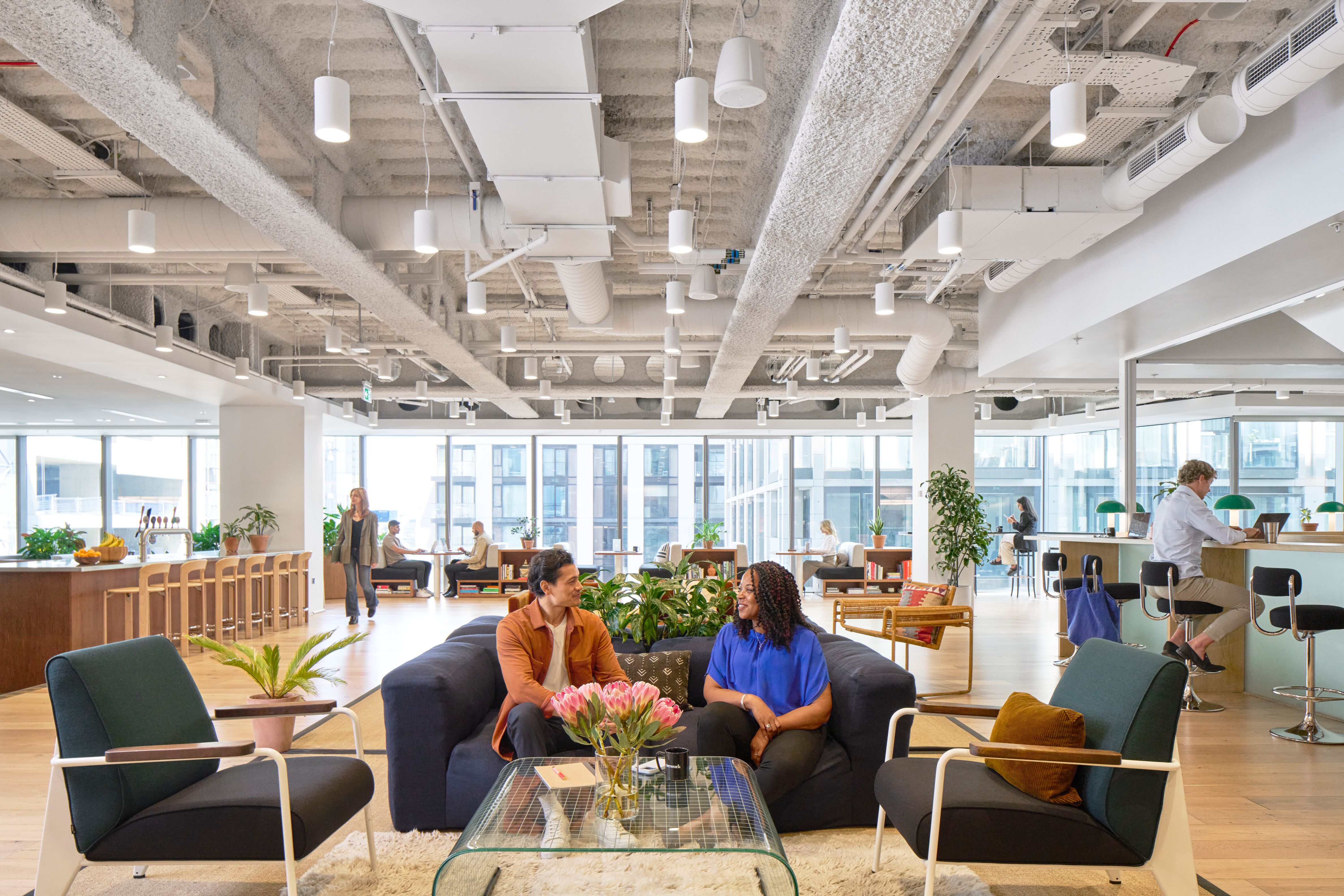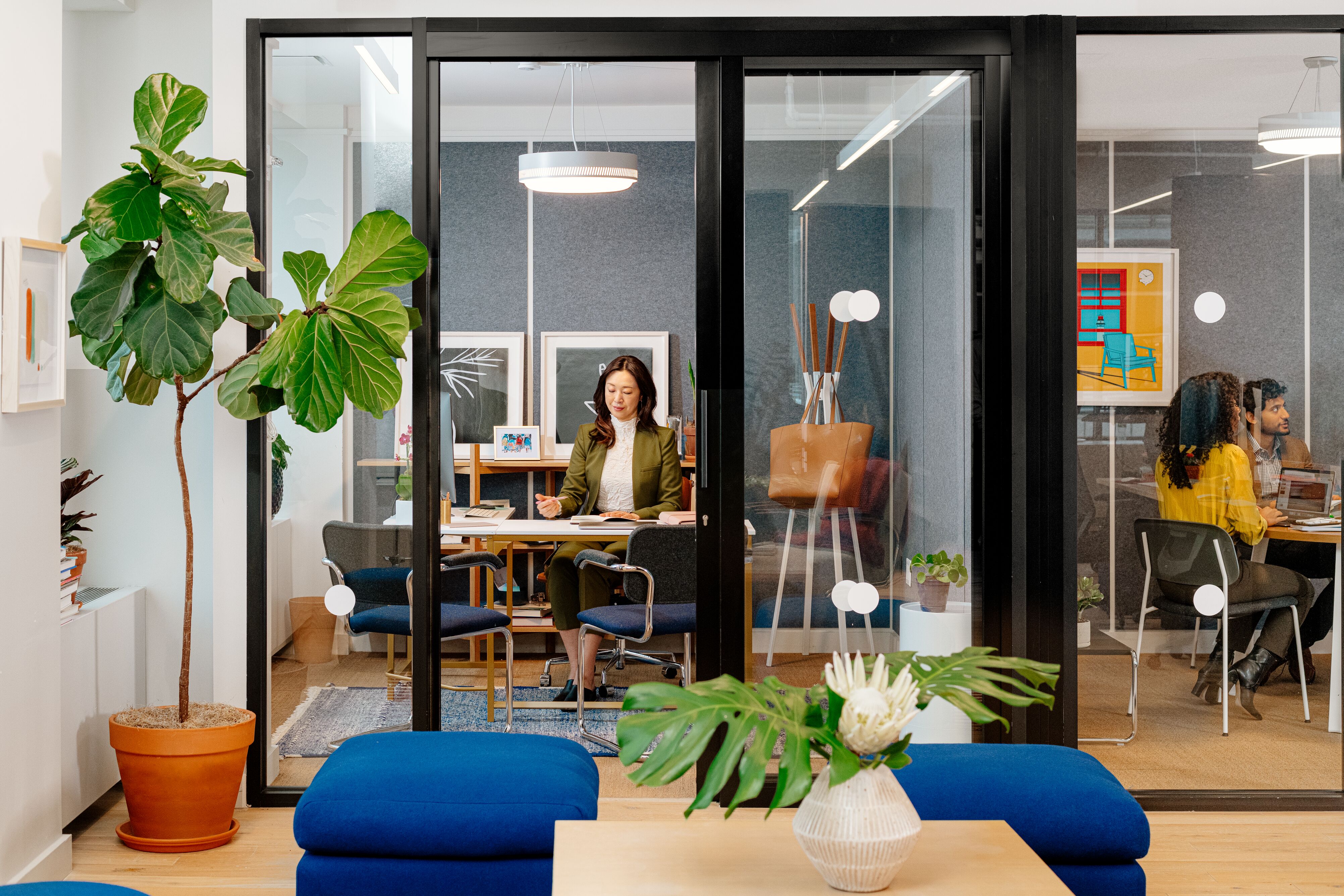De-densification is the process of reducing office density by staggering attendance, expanding available floor space with satellite offices, or rearranging existing layouts to create additional room.
- Meaning of “office density”
- Why should you care about office de-densification?
- Redesign the workspace for de-densification
- De-densification with social distancing in mind
- Home office as a de-densification solution
- How WeWork can help you de-densify your office with WeWork All Access and WeWork On Demand
In the last year, de-densification has emerged as perhaps the most important aspect of office design. The rise of the open-plan office in the late 20th century tore down cubicle barriers and brought teams closer to one another. Now, in the wake of a pandemic that upended the way we work and made office safety a number one priority, employees need more space.
In this article, we’ll take a look at some of the reasons why companies are turning to de-densification as a way back to working in the office, how de-densification can have benefits beyond the pandemic recovery, and some tips for achieving it in your workplace.
But first, let’s nail down what we mean when we talk about office density.
Meaning of “office density”
Office density, or employment density, is a measure of how much space any given worker has on average. It’s found by dividing the occupied floor space of an office by the number of full-time-equivalent employees working there.
Of course, employees aren’t evenly spread out across an entire office like chess pieces, so it’s necessary to divide up the space into a bunch of discrete areas when you’re trying to gauge office density across the entire workplace. Vacant space should be ignored, as this distorts the result.
Why should you care about office de-densification?
Even before the pandemic hit, office design was trending away from tightly packed desks and toward more open and flexible workspaces.
De-densification solves many social distancing design problems, but it also creates room for a more dynamic way of working. A less crowded office makes space for shared areas where collaboration and creativity can flourish.

It’s also what employees want. Workers are cautious about a full return to the old-style office. The benefits of remote working are a big reason behind this but so is the importance of personal space. Research by the National Retail Foundation and Prosper Insights & Analytics found that 34 percent of workers are concerned about being unable to socially distance themselves from colleagues around the office.
A less dense office is optimized not only for safety but also for comfort and functionality. The idea of cramming thousands of people into a single building is likely a thing of the past—de-densification is the alternative that gives employees the breathing room they need to do their best work.
Redesign the workspace for de-densification
Reducing the density of an office doesn’t necessarily require adding more floor space. It’s possible to de-densify by limiting the number of employees in the office at any given time, or by adapting the existing layout to make more effective use of unoccupied space.
Some adaptations are more effective than others when it comes to preventing the spread of the coronavirus, but all help allay anxieties about returning to the office. Here are some features of the de-densified workspace:
- Separated groups. The most popular way to achieve a de-densified office without increasing floor space is to invite groups of employees to attend the office at the same time, while the remaining staff works remotely or from home. By grouping workers based on projects and departments, in-office time can be dedicated to planning and meeting.
- Smaller meeting rooms. Meeting and conference rooms typically comprise the bulk of the unused floor space in an office. Consider removing rooms or reducing them in size to allow employees to spread out and make more effective use of the office space.
- Desk dividers. The rise of open-plan office design stripped out dividing walls between cubicles and brought employees a little closer together. Now walls are making a comeback. Enclosed personal spaces enable social distancing and can be complemented by shared spaces where project work and collaboration can happen.
- Office cleaning. The return to the office can only happen with enhanced hygiene measures and frequent cleaning. De-densification reduces clutter around the office, making it possible to safely access surfaces and to know when desks will be unattended and ready for cleaning.
- Contactless appliances. As well as giving each employee more personal space, a de-densified office should try to reduce contact with high-touch surfaces as much as possible. NFC keycards can replace touchpads, while appliances in shared areas, such as coffee and vending machines, can be upgraded to contactless alternatives.
De-densification with social distancing in mind
Nobody is certain how long current social distancing requirements will last. There’s a chance we might never go back to pre-pandemic office densities, whether that’s because of government guidelines, employee preferences, or both.
As well as helping to achieve flexibility in the workplace, de-densification plays a key role in social distancing. Rearranging desks places employees more than six feet apart and creates space for one-way traffic systems. Offices with lower occupancy experience less crowding in busy spots such as restrooms, kitchens, and elevator waiting areas.
Home office as a de-densification solution
Hybrid offices allow employees to split their time between working from the office and working from places other than the office. By continuing to lean into this flexible mode of working even after COVID-19 restrictions are lifted, companies can reduce the number of workers needed in the office at any one time and use that headroom to de-densify without expanding.

But transitioning to a hybrid office doesn’t have to mean your employees work from home. Satellite offices and coworking spaces near where your employees live can offer productivity-enhancing workspaces away from the potential distractions of home, while still providing the benefits of remote working: shorter commutes, more autonomy, and a better work-life balance.
How WeWork can help you de-densify your office with WeWork All Access and WeWork On Demand
If you don’t have the physical floor space to safely return all of your employees to the workplace at once, de-densification is still an option—and it doesn’t require being locked into long-term leases or costly build-outs.
By moving some employees to a satellite office, or by providing workers with a dedicated workspace closer to their homes, businesses can quickly de-densify their existing space.
WeWork offers flexible office solutions for businesses that need some extra room to reduce office density and maintain social distancing for their teams. With WeWork All Access, you can give your employees a dedicated workspace or open a satellite office in any one of hundreds of WeWork locations around the world.
For last-minute flexibility, WeWork On Demand gives you access to stylishly designed workspaces and meeting rooms in dozens of cities across the United States, with no monthly commitment to worry about.
You can search, book, and pay for available office space from $29 per day with the WeWork On Demand app. To get started, download the app and create an account to begin exploring WeWork On Demand locations near you. To unlock hundreds of WeWork locations globally, visit WeWork All Access and try out one month for free.
Steve Hogarty is a writer and journalist based in London. He is the travel editor of City AM newspaper and the deputy editor of City AM Magazine, where his work focuses on technology, travel, and entertainment.
Rethinking your workspace?










